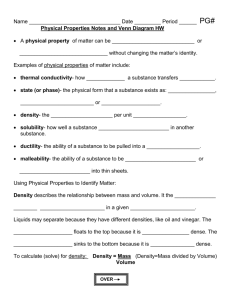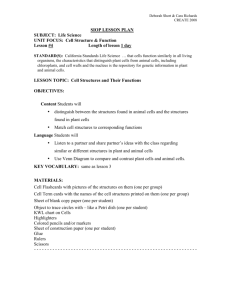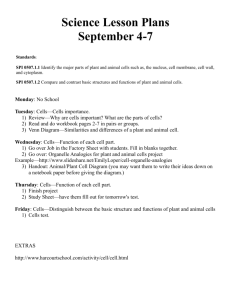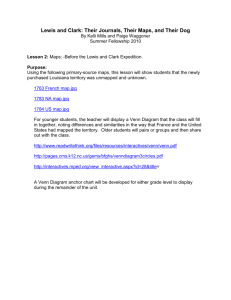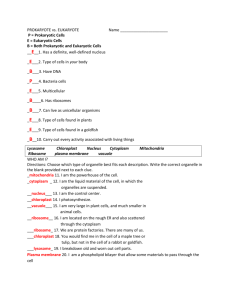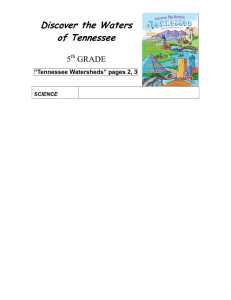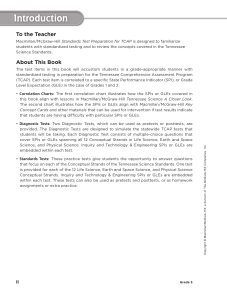LESSON PLAN Name: Kellie Ball and Dayna Walker Date: 2/15/12
advertisement
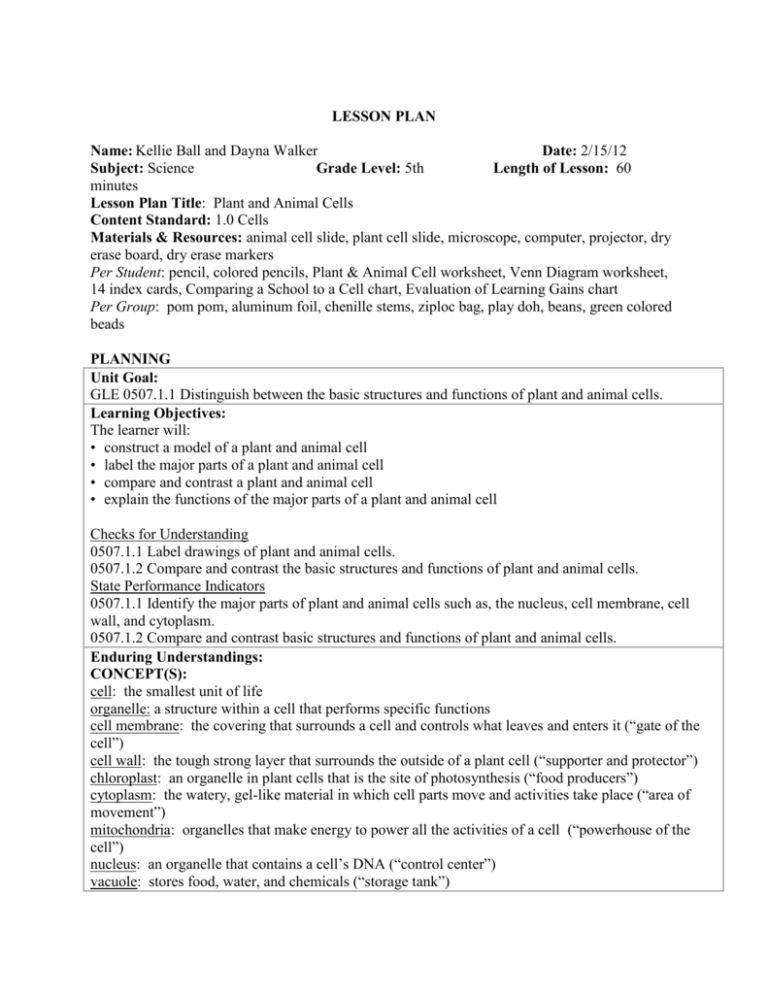
LESSON PLAN Name: Kellie Ball and Dayna Walker Date: 2/15/12 Subject: Science Grade Level: 5th Length of Lesson: 60 minutes Lesson Plan Title: Plant and Animal Cells Content Standard: 1.0 Cells Materials & Resources: animal cell slide, plant cell slide, microscope, computer, projector, dry erase board, dry erase markers Per Student: pencil, colored pencils, Plant & Animal Cell worksheet, Venn Diagram worksheet, 14 index cards, Comparing a School to a Cell chart, Evaluation of Learning Gains chart Per Group: pom pom, aluminum foil, chenille stems, ziploc bag, play doh, beans, green colored beads PLANNING Unit Goal: GLE 0507.1.1 Distinguish between the basic structures and functions of plant and animal cells. Learning Objectives: The learner will: • construct a model of a plant and animal cell • label the major parts of a plant and animal cell • compare and contrast a plant and animal cell • explain the functions of the major parts of a plant and animal cell Checks for Understanding 0507.1.1 Label drawings of plant and animal cells. 0507.1.2 Compare and contrast the basic structures and functions of plant and animal cells. State Performance Indicators 0507.1.1 Identify the major parts of plant and animal cells such as, the nucleus, cell membrane, cell wall, and cytoplasm. 0507.1.2 Compare and contrast basic structures and functions of plant and animal cells. Enduring Understandings: CONCEPT(S): cell: the smallest unit of life organelle: a structure within a cell that performs specific functions cell membrane: the covering that surrounds a cell and controls what leaves and enters it (“gate of the cell”) cell wall: the tough strong layer that surrounds the outside of a plant cell (“supporter and protector”) chloroplast: an organelle in plant cells that is the site of photosynthesis (“food producers”) cytoplasm: the watery, gel-like material in which cell parts move and activities take place (“area of movement”) mitochondria: organelles that make energy to power all the activities of a cell (“powerhouse of the cell”) nucleus: an organelle that contains a cell’s DNA (“control center”) vacuole: stores food, water, and chemicals (“storage tank”) ESSENTIAL QUESTIONS: Knowledge: What is the function of the nucleus?; What is the function of the vacuole?; What is the function of mitochondria?; What is the function of cytoplasm?; What is the function of chloroplasts?; What is the function of the cell wall?; What is the function of the cell membrane? Comprehension: What materials can be used to represent a plant cell?; What materials can be used to represent an animal cell? Application: Show us how to model a plant cell using the materials provided.; Show us how to model an animal cell using the materials provided. Analysis: What similarities do you see between animal and plant cells?; What differences do you notice between animal and plant cells? Why does an animal cell not contain a chloroplast? Synthesis: What would happen if one of the parts of a cell was not working? How is a school like a cell? Evaluation: Is there any one part of a cell that is more important than the others? Interdisciplinary Connections: Math: Students will compare three-dimensional objects with two-dimensional representations of those objects, such as plant/animal cells. GLE 0506.4.1 Use basic formulas and visualization to find the area of geometric figures. SPI 0506.4.3 Identify a three-dimensional object from two-dimensional representations of that object and vice versa. Social Studies: Think of a group, organization, or business that relies on interdependence. In other words, think of a “cell” or a group of people that mutually rely on each other for a common cause or goal. Research the “cell” of your choice and briefly explain: (1) the purpose or goal of the “cell”, (2) a few important functions or jobs the people within the cell carry out, and (3) what would happen to the “cell” if one of those important functions did not work properly. GLE 6.02 Understand how groups can impact change at the local, state, and national level. 5.6.spi.4 Explain how individuals, groups, and nations interact through conflict, cooperation, and interdependence. Language Arts: Pretend you are one of the organelles that we discussed in class. Write a short story about your adventures inside of a cell. Describe what type of cell you are in, what your job is, what you see, what you are doing, what is happening around you, how you are traveling, and how you are reacting with other organelles in the cell. GLE 0501.3.2 Write in various modes and genres, including narration, literary response, personal expression, description, and imaginative. SPI 0501.3.8 Select vivid and active words for a writing sample. INSTRUCTION INTRODUCTION or Anticipatory Set Time: 10 minutes Engage: Part I. Show the students two slides on the board using a microscope. DO NOT tell the students what the slides are of. Slide 1 is of an animal cell and the slide 2 is of a plant cell. Ask students to form a human scatterplot based on what they think the slides consist of (FACT #24 Human Scatterplots). Display three answers on the board that students can choose from and where to stand in the room according to answer they choose. The three answers will be as follows: (A) slide 1 = plant cell, slide 2 = animal cell; (B) slide 1 = animal cell, slide 2 = plant cell; (C) slide 1 = leaf, slide 2 = red blood cell, (D) slide 1 = white blood cell, slide 2 = strand of hair. The placements will be as follows: students who choose answer A will stand by the windows, students who choose answer B will stand by the door, students who choose answer C will stand in the front of the room by the white board, and students who choose answer D will stand in the back of the room. The teacher will ask student volunteers to explain why they chose their answer. (5 minutes) Part II. The teacher will discuss the correct answer. Ask the students what they observed from the slides. Ask those who knew the correct answer, how they knew that slide 1 was an animal cell and slide 2 was a plant cell. Discuss how plant and animal cells are quite similar, but also have a few differences. (5 minutes) BODY (Activities & Practice) Activities Time: 40 minutes Explore I: (5 minutes) In groups, ask students to construct a plant and an animal cell out of the materials provided; one plant and one animal cell per group. Students are to construct cells to the best of their abilities based only on their previous knowledge of cells. Explain I: (10 minutes) Students share their cell creations. The teacher will show the class what an appropriate model of an animal cell and plant cell should look like using the same materials the class used. The teacher will identify the major parts of a cell and ask students to label a drawing of each cell as she explains. Explore II: (5 minutes) Using their labeled drawings, each student will create a Venn diagram comparing the major parts of the plant cell and the animal cell. Explain II: (10 minutes) The students will share their comparisons between plant and animal cells. The teacher will illustrate a correct Venn diagram. The teacher will now explain the functions of each major part of a cell (nucleus, cell membrane, cell wall, vacuole, mitochondria, cytoplasm, and chloroplast). The students will create flashcards by folding index cards in half. On the left side, the students will write the name of the cell structure. On the right side, the students will illustrate the structure and write its function. Extend: (10 minutes) Students will use their prior knowledge from the lesson to extend their knowledge about cell parts and functions. Just like a cell, different parts of a school work together to run the entire school. Ask the students how a school can be compared to a cell. The students will be given a chart to complete. Students are to identify what part of a cell can be compared to a part of a school. Next students will briefly explain the function of each part within a school and within a cell. Practice/Assessment Time: 5 minutes Evaluate: Students will practice matching their cell structure and function flashcards. Students will complete a Student Evaluation of Learning Gains assessment. (FACT #57). CLOSURE Time: 5 minutes The teacher will refer to the essential questions, asking the class at least one question from each level. ASSESSMENT Evaluation: Informal: The teacher will observe students while they create and label animal and plant cells. The teacher will observe the students while they create their Venn Diagram and while they match the cell structure to its function using their flashcards. Student understanding will be determined throughout class discussions. Formal: The teacher will review the Student Evaluation of Learning Gains assessment and gather feedback on how well the students learned the material. The teacher will review the students’ worksheets on comparing a school to a cell for accuracy. Alternative and/or Supplemental Activities/Extensions: Part I: E-Learning -- Students can explore these virtual websites during learning center time. These sites will also be listed on the class web page so students can also interact with them at home. 1. Cell Models: An Interactive Animation This interactive website provides animated models of plant and animal cells. Students can click on different cell parts to learn about their function. This site also contains animated images of the cell cycle, “real time” cell cams documenting cell growth, as well as jigsaw and word puzzles. http://www.cellsalive.com/cells/cell_model.htm 2. Slide Puzzles Plant and animal puzzles in which children slide pieces of a cell to rearrange it to its correct order. http://www.neok12.com/slide-puzzle/Cell-Structures-05.htm 3. Cell Inspector An interactive website that allows students to label cells by dragging the terms to the appropriate spot on the cell. The game checks for correct answers and produces various drawings of cells so that students can practice. http://www.harcourtschool.com/activity/cell/cell.html Part II: Explore Trade Books - During centers or reading time allow students to explore the following books: Powerful Plant Cells (2007) by Rebecca L. Johnson and Mighty Animal Cells (2007) by Rebecca L. Johnson. Differentiation – Accommodations for Individual Learners: Bodily-Kinesthetic: Students actively create and label plant and animal cells using their hands. Interpersonal: Students will work in groups to create their plant and animal cells. Intrapersonal: Students will complete their own Student Evaluation of Learning Gains at the end of the lesson, allowing them to reflect on their learning. Logical-Mathematical: Students will make comparisons between the functions of cells and the functions of a school. Spatial: Students will label a picture of a cell. Students will observe plant and animal cells through a microscope. Students will create and match flashcards labeled with cell parts and their functions. Students will create a Venn diagram observing similarities and differences among plant and animal cells. References: The Children’s Museum of Indianapolis. (2007). Yesterday, today, and tomorrow: agricultural biotechnology. Retrieved from http://www.childrensmuseum.org/sites/default/files/files/%20TCM%20BIOTECH%20UOS.pdf • Used for comparing a school to a cell in Extend section and labeling plant and animal cells Haugen, H. (1998). Journey into a cell. Retrieved from http://www.accessexcellence.org/AE/ATG/data/released/0504-HeidiHaugen/index.php • Used for Language Arts idea in Interdisciplinary Connections section. Mountain City Elementary School. (2009). Grade 5: standard 1 - cells. Retrieved from http://www.mce.k12tn.net/science2/life_science_5/cells/cells_5thgrade.htm • Concepts used for cell activities. Comparing Plant And Animal Cells Venn Diagram. Retrieved from www.swsd.k12.pa.us/staff/jenn.../CellWebquest_VennDiagram.doc • Printable Venn Diagram used for Explain II section.
